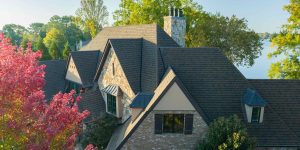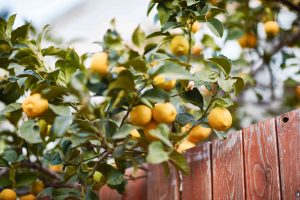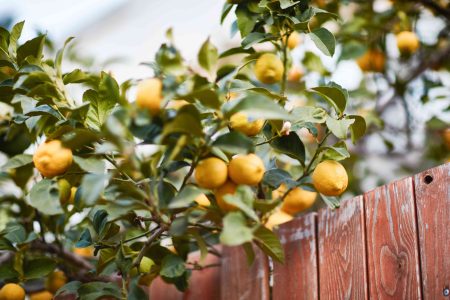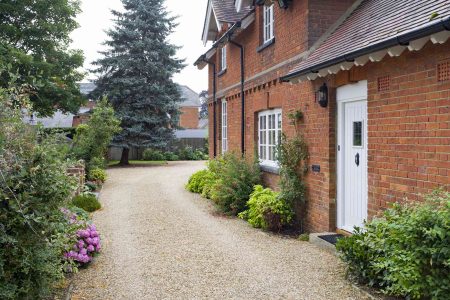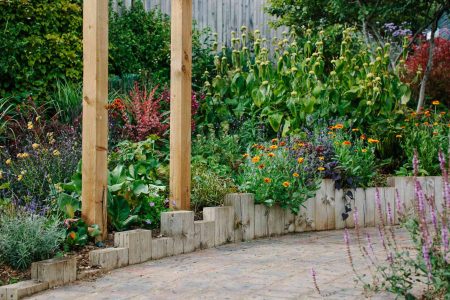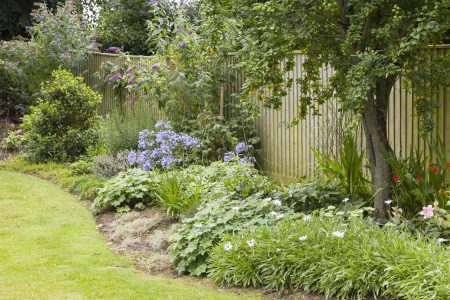Having a fence or wall built in your yard is not the only way to add privacy. You can also position plants strategically in your yard to keep prying eyes out. While shrubs are most commonly used to achieve privacy, trees, vines, and other plants can also serve this purpose.
Privacy shrubs are sometimes sheared to form neat hedges, but they can also be grouped more loosely along a border. One of the advantages growing plants has over building fences to gain privacy is that they may attract wildlife and/or change seasonally to create greater landscape interest.
Here are 20 plants and shrubs that will add privacy to your yard.
-
01
of 20Hick’s Yew
Yew is a perfect shrub choice for privacy. Its needled foliage is evergreen, so you don’t have to worry about losing privacy when winter comes.
A row of yew shrubs can easily be clipped into a neat hedge, as they are tough and hardy plants. As long as they have good drainage, yews will thrive if you simply water them during droughts and prune and fertilize them annually. As a bonus, yew produces attractive red berries (arils).
Hick’s yew is a great selection for privacy hedges because of its height. Because it is column-shaped, it can be grown in a loose border if you don’t want to bother with a formal hedge.
- Name: Hick’s yew (Taxus × media ‘Hicksii’)
- USDA Hardiness Zones: 2 to 10
- Color: Green leaves, red berries
- Light: Full sun to partial shade
- Soil: Well-drained, loamy, moist
- Mature Size: 15 feet high by 20 feet wide
-
02
of 20Emerald Green Arborvitae
Emerald Green arborvitaes are medium-sized for their genus. They are sure to look attractive either clipped as a formal hedge or arranged to form a loose border. Arborvitaes don’t offer much aesthetically outside of their dense foliage that stays green all year; their function is mainly to add privacy to a yard.
A major drawback is that arborvitae is generally intolerant of drought. Be sure to keep their soil evenly moist throughout the summer.
- Name: Emerald Green arborvitae (Thuja occidentalis ‘Emerald Green’)
- USDA Hardiness Zones: 2 to 7
- Color: Green, scale-like, evergreen leaves
- Light: Full sun to partial sun
- Soil: Well-drained, moist
- Mature Size: 12to 20 feet tall, 3 to 10 feet wide
-
03
of 20Green Giant Arborvitae
Most types of arborvitae shrubs are not exceptionally fast-growing, but the Green Giant variety is an exception: it can grow as much as 5 feet per year. It is also a tall arborvitae, making it a great choice for privacy. It’s best grown as a loose border rather than kept neatly sheared.
- Name: Green Giant arborvitae (Thuja plicata x T. standishii)
- USDA Hardiness Zones: 2 to 7
- Color: Green, scale-like, evergreen leaves
- Light: Full sun to partial sun
- Soil: Well-drained, moist
- Mature Size: 40 to 60 feet tall, 12 to 18 feet wide
-
04
of 20Common Juniper
Junipers have awl-shaped, evergreen leaves. The species plant is a low-spreading shrub (about 5 feet tall by 13 feet wide). But, homeowners are more interested in the cultivars. These range from tall, tree-like shrubs to short groundcovers.
Homeowners seeking privacy will want one of the taller types, such as ‘Hibernica’ (15 feet). Common junipers are hardy and need little care, but they perform best in moist, well-draining soil and in full sun.
- Name: Common juniper (Juniperus communis)
- USDA Hardiness Zones: 2 to 7
- Color: Green, awl-like, evergreen leaves
- Light: Full sun
- Soil: Well-drained
- Mature Size: Depends on cultivar
Continue to 5 of 20 below. -
05
of 20Pfitzer Chinese Juniper
Pfitzer juniper is the type you often see sheared into pom-poms, but if growing for privacy, it’s best to let it grow into its natural shape, instead. It is not as cold-hardy as common juniper and is susceptible to root rot, so ensure that it soil drains well.
- Name: Chinese juniper (Juniperus chinensis ‘Pfitzeriana’)
- USDA Hardiness Zones: 4 to 9
- Color: Sage-green, awl-like, evergreen leaves
- Light: Full sun
- Soil: Well-drained
- Mature Size: 5 to 10 feet tall and 15 to 20 feet wide
-
06
of 20Mountain Laurel
Mountain laurel is a good choice for privacy if your screen will be growing in the shade. Its foliage does well in patial shade, although it needs more sun to bloom to its full potential.
Fertilize it in spring with a plant food formulated for acid-loving shrubs. To avoid root rot, don’t plant it too deeply (the crown shouldn’t be buried).
- Name: Mountain Laurel (Kalmia latifolia)
- USDA Hardiness Zones: 4 to 9
- Color: Rose, pink, or white flowers; green leaves
- Light: Full sun to partial shade
- Soil: Cool, rich, moist, well-drained, acidic
- Mature Size: 5 to 15 feet tall and wide
-
07
of 20Privet
Privet is almost synonymous with privacy. Depending on the type, this broadleaf shrub can be either evergreen or deciduous. It is most often planted in rows and sheared into a formal hedge.
- Name: Privet (Ligustrum spp.)
- USDA Hardiness Zones: 3 to 8
- Color: Glossy green leaves; white flowers succeeded by black berries
- Light: Full sun to partial shade
- Soil: Well-drained
- Mature Size: 4 to 15 feet tall, 4 to 10 feet wide
-
08
of 20Golden Privet
If the common green of regular privet doesn’t suit you, try the ‘Vicaryi’ cultivar. It sports bright, golden leaves, but it can be used in the same way as regular privet. Grow it next to dark plants for a striking contrast.
- Name: Golden privet (Ligustrum ‘Vicaryi’)
- USDA Hardiness Zones: 5 to 8
- Color: Golden leaves; white flowers succeeded by black berries
- Light: Full sun to partial shade
- Soil: Well-drained
- Mature Size: 6 to 12 feet tall, 7 to 10 feet wide
Continue to 9 of 20 below. -
09
of 20English Holly
Holly is a classic broadleaf shrub associated with the winter holidays. In addition to obscuring the unwanted glances of passersby, its prickly leaves deter would-be trespassers. The main care it requires is to be given a soil that drains well and has an acidic pH.
- Name: English holly (Ilex aquifolium)
- USDA Hardiness Zones: 7 to 9
- Color: Glossy, green broadleaf plant with red berries
- Light: Full sun to partial shade
- Soil: Well-drained, acidic
- Mature Size: 3 to 50 feet tall, 15 to 25 feet wide
-
10
of 20Blue Prince and Blue Princess Holly
Blue Princess and its pollinator, Blue Prince is another choice in broadleaf, evergreen shrubs for privacy. They are sometimes planted as hedges, but they also work well grouped more loosely along a border.
- Name: Blue Prince/Princess holly (Ilex x meserveae ‘Blue Prince’/’Blue Princess’)
- USDA Hardiness Zones: 3b to 7a
- Color: Glossy, dark green with bluish cast; red berries
- Light: Full sun to partial shade
- Soil: Well-drained, acidic
- Mature Size: 15 feet tall, 8 to 10 feet wide
-
11
of 20English Ivy
Vines can also add privacy to your yard. The drawback with vines is that they require some kind of support, like a pergola or fence. In the case of chain-link, homeowners often cover it with a vine to disguise it (since it is unattractive). Thus the vine does double-duty, adding privacy and enhancing the appearance of the yard.
The best vines to grow for privacy are woody vines. as they have a head start each growing season on vines that have to re-emerge from the ground every spring and will provide privacy more quickly. If they happen to be evergreen, too, they will give you year-round privacy.
English ivy is an example of an evergreen vine.
- Name: English ivy (Hedera helix)
- USDA Hardiness Zones: 4 to 13
- Color: Rich green foliage with lighter-colored veining
- Light: Partial shade to full shade
- Soil: Fertile and moist
- Mature Size: N/A; climbs and spreads as much as possible
Warning
English ivy is invasive in North America. Fortunately, there are some non-invasive alternatives to English ivy, although these vines are not evergreen.
-
12
of 20American Wisteria
American wisteria and other deciduous vines will add privacy only in summer in fall. But, wisteria is worth growing for its racemes of flowers alone. Make sure to give woody vines sturdy support, as they become very heavy over time.
- Name: Wisteria (Wisteria frutescens)
- USDA Hardiness Zones: 5 to 9
- Color: Bluish or purplish flowers
- Light: Full sun to partial shade
- Soil: Well-drained
- Mature Size: 10 to 25 feet long, 4 to 8 feet wide
Continue to 13 of 20 below. -
13
of 20Dutchman’s Pipe
The “pipe” in the name comes from the shape of its flowers, but Dutchman’s pipe’s floral display is much less impressive than wisteria’s. This deciduous vine does, however, have dense foliage, making it a good privacy plant. Avoid overhead watering, otherwise, you invite fungal diseases on this woody vine.
- Name: Dutchman’s pipe (Aristolochia macrophylla)
- USDA Hardiness Zones: 4 to 8
- Color: White flowers
- Light: Full sun to partial sun
- Soil: Well-drained
- Mature Size: 15 to 30 feet tall, 15 to 20 feet wide
-
14
of 20Climbing Hydrangea
A lot of plants are listed as suitable for partial shade, but many of those fail to reach their full potential under such conditions (they tolerate partial shade, but they don’t thrive in it). Not so with the climbing hydrangea. One of the great virtues of this woody vine is that it performs so well in shade, giving you a great choice for privacy in such areas.
- Name: Climbing hydrangea (Hydrangea anomala)
- USDA Hardiness Zones: 4a to 8a
- Color: Medium-green leaves, white flowers
- Light: Full sun to partial shade
- Soil: Well-drained
- Mature Size: 30 to 50 feet tall, 5 to 6 feet wide
-
15
of 20Arctic Kiwi Vine
Arctic kiwi is a woody vine that offers variegated foliage in pink, white, and green. The colors are most intense in spring, fading as the summer proceeds. A heavy feeder, this plant needs a lot of nitrogen. Work about 3 inches of compost into its soil each spring to keep it fed.
- Name: Arctic kiwi (Actinidia kolomikta)
- USDA Hardiness Zones: 3 to 9
- Color: Pink, white, and green variegated foliage
- Light: Full sun to partial sun
- Soil: Well-drained, loamy
- Mature Size: Up to 30 feet long
-
16
of 20Copper Beech
Trees, too can be used to screen out prying eyes. For small and medium-sized properties, the best privacy trees are generally those that stay short and/or get bushy when pruned.
Evergreens typically make the best privacy screens, as they keep their foliage year-round, whereas most deciduous trees drop their leaves in fall. An exception is copper beech. It is easily kept compact through pruning, making it popular for privacy screens.
- Name: Copper beech (Fagus sylvatica Atropurpurea Group)
- USDA Hardiness Zones: 4 to 7
- Color: Purple leaves turn coppery in winter
- Light: Full sun to part shade
- Soil: deep, fertile, and moist, but well-drained
- Mature Size: 50 to 60 feet high, 30 to 45 feet wide
Continue to 17 of 20 below. -
17
of 20Canadian Hemlock
Another tree used in privacy screens is hemlock. Cultivars exist that stay short enough to be used in hedges without excessive pruning. ‘Aurea Compacta’ has golden-colored foliage and reaches just 5 feet in height, with a spread of only about half that.
- Name: Canadian hemlock (Tsuga canadensis)
- USDA Hardiness Zones: 3 to 7
- Color: Evergreen needles
- Light: Full sun to partial shade
- Soil: Well-drained, moist
- Mature Size: 70 feet high, 25 to 35 feet wide
-
18
of 20Eastern White Pine
A third example of a tree used in privacy screens is the Eastern white pine. It is easily pruned to maintain it in a shrub form.
- Name: Eastern white pine (Pinus strobus)
- USDA Hardiness Zones: 3 to 8
- Color: Evergreen needles
- Light: Full sun to partial sun
- Soil: Well-drained
- Mature Size: 50 to 80 feet tall, 20 to 40 feet wide
-
19
of 20Maiden Grass
Tall ornamental grasses also make good plants for privacy, and maiden grass is one example. While some growers cut it back in late fall, those who want to use it in a privacy screen will leave the dried canes in place all winter. In fact, the plant provides considerable winter interest.
- Name: Maiden grass (Miscanthus sinensis)
- USDA Hardiness Zones: 5 to 9
- Color: Green leaf blades; coppery flower heads in early fall later transform into silvery white plumes for winter interest
- Light: Full sun to partial sun
- Soil: Well-drained
- Mature Size: 4 to 12 feet tall, 4 to 6 feet wide
-
20
of 20Black Bamboo
Black bamboo is a running bamboo. It spreads vigorously via underground rhizomes. But be careful, as bamboos are considered invasive plants outside their native ranges.
Its aggressive nature can be good or bad, depending on your objectives. If you are looking to create a privacy screen, this plant’s nature can be put to your advantage. Black bamboo is also effective in noise barriers.
- Name: Black bamboo (Phyllostachys nigra)
- USDA Hardiness Zones: 7 to 10
- Color: Black stalks
- Light: Full sun to partial shade
- Soil: Well-drained, moist, loamy
- Mature Size: 30 feet tall, 2 inches wide
Read the full article here



